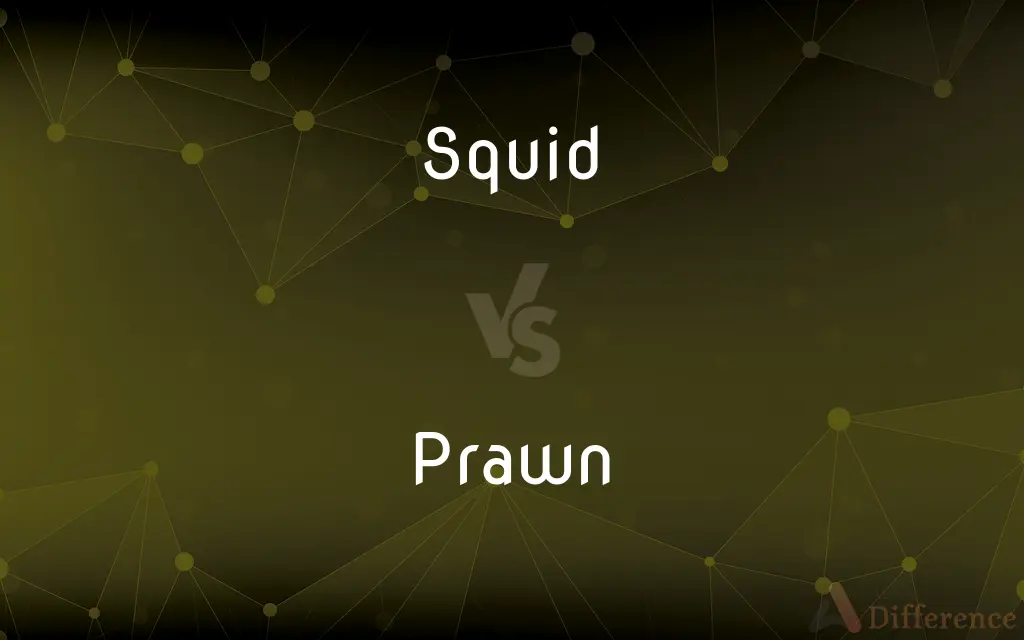Squid vs. Prawn — What's the Difference?
By Maham Liaqat & Urooj Arif — Updated on April 6, 2024
Squid are cephalopods with elongated bodies and tentacles, known for their ink, while prawns are crustaceans with segmented bodies and exoskeletons, famed for their sweetness.

Difference Between Squid and Prawn
Table of Contents
ADVERTISEMENT
Key Differences
Squid belong to the cephalopod family, which includes creatures like octopuses and cuttlefish. They have a distinct head, bilateral symmetry, a mantle, and tentacles. Squid are known for their ability to squirt ink as a defense mechanism. Prawns, on the other hand, are crustaceans related to crabs and lobsters, characterized by their segmented bodies and hard exoskeletons. Unlike squid, prawns cannot produce ink.
The habitat of squid is primarily in the open ocean, where they live in both shallow and deep waters. They are often found in schools and can be highly migratory. Prawns tend to inhabit fresh and saltwater environments, often found on the ocean floor or in rivers and lakes, making their habitats more diverse than those of squid.
Squid are carnivores, feeding on fish, smaller squid, and other marine organisms, using their tentacles to capture prey. Prawns are generally omnivores, eating plant material along with small aquatic creatures, which reflects the differences in their ecological roles and feeding behaviors.
In culinary contexts, squid is celebrated for its firm texture and mild flavor, often prepared as calamari or added to paellas. Prawns are prized for their sweet, delicate flavor and are a staple in dishes ranging from shrimp cocktails to curries, highlighting the contrast in taste and preferred cooking methods between the two.
Reproduction in squid involves the male depositing a spermatophore in the female, with some species engaging in complex mating rituals. Prawns, however, have a more straightforward reproductive process, with females carrying the fertilized eggs until they hatch, showcasing differences in their life cycles and reproductive strategies.
ADVERTISEMENT
Comparison Chart
Classification
Cephalopods
Crustaceans
Body Structure
Elongated bodies with tentacles
Segmented bodies with an exoskeleton
Defense Mechanism
Can squirt ink
Lacks ink-squirting ability
Habitat
Open ocean, both shallow and deep waters
Fresh and saltwater, ocean floor, rivers
Diet
Carnivorous, feeds on fish and marine life
Omnivorous, eats plants and small animals
Culinary Uses
Firm texture, used in calamari, paellas
Sweet, delicate flavor, used in cocktails, curries
Reproduction
Complex, involves spermatophores
Females carry fertilized eggs until hatching
Compare with Definitions
Squid
Marine cephalopods with a mantle and tentacles.
Squid ink is a key ingredient in black risotto.
Prawn
Omnivorous feeders.
Prawns feed on algae and small aquatic organisms.
Squid
Have elongated bodies.
The squid's elongated body helps it navigate swiftly in the water.
Prawn
Live in various water environments.
Freshwater prawns thrive in rivers and lakes.
Squid
Known for their ability to squirt ink.
The squid escaped predators by releasing ink.
Prawn
Crustaceans with segmented bodies.
Prawns were added to the seafood paella for extra flavor.
Squid
Carnivorous diet.
Squid often hunt small fish and crabs.
Prawn
Valued for their sweet taste.
Prawns are a delicacy in many Asian cuisines.
Squid
Used in diverse cuisines.
Grilled squid is a popular dish in Mediterranean cuisine.
Prawn
Used in a wide range of dishes.
Prawn curry is a staple in coastal regions.
Squid
Squid are cephalopods in the superorder Decapodiformes with elongated bodies, large eyes, eight arms and two tentacles. Like all other cephalopods, squid have a distinct head, bilateral symmetry, and a mantle.
Prawn
Prawn is a common name for small aquatic crustaceans with an exoskeleton and ten legs (which is a member of the order decapoda), some of which can be eaten.The term "prawn" is used particularly in the United Kingdom, Ireland, and Commonwealth nations, for large swimming crustaceans or shrimp, especially those with commercial significance in the fishing industry. Shrimp that are present in this category often belong to the suborder Dendrobranchiata.
Squid
A device that measures minute changes in magnetic flux by means of one or more Josephson junctions, often used to detect extremely small changes in magnetic fields, electric currents, and voltages.
Prawn
Any of various shrimps, especially one that is large or inhabits fresh water.
Squid
Any of various marine cephalopod mollusks of several families of the superorder Decapodiformes (or Decabrachia), having a usually elongated body, eight arms and two tentacles, a reduced or absent internal shell, and a pair of fins.
Prawn
The flesh of a prawn, used as food.
Squid
Any of several carnivorous marine cephalopod mollusks, of the order Teuthida, having a mantle, eight arms, and a pair of tentacles
Prawn
To fish for prawns.
Squid
A fishhook with a piece of bright lead, bone, or other substance fastened on its shank to imitate a squid.
Prawn
A crustacean of the suborder Dendrobranchiata.
Squid
A sailor in the Navy.
Prawn
(Commonwealth) A crustacean, sometimes confused with shrimp.
Squid
A quid; one pound sterling.
Can you lend me five squid? I feel like a bacon sarnie.
Prawn
Synonym of butterface: A woman with an attractive body but an unattractive face.
She's a prawn!
Squid
A motorcyclist, especially a sport biker, characterized by reckless riding and lack of protective gear.
"In my mind, a street squid is anyone who races on the street. Period."1
"squid: a cocky motorcyclist who darts very aggressively through traffic"2
Prawn
A fool, an idiot.
Squid
(angling) To fish with the kind of hook called a squid.
Prawn
Alternative form of porn.
Squid
(parachuting) To cause squidding an improper, partial, parachute inflation, that results in the sides of the parachute folding in on the center, and pulsating back and forth.
Prawn
(intransitive) To fish for prawns.
Squid
Any one of numerous species of ten-armed cephalopods having a long, tapered body, and a caudal fin on each side; especially, any species of Loligo, Ommastrephes, and related genera. See Calamary, Decacerata, Dibranchiata.
Prawn
Any one of numerous species of large shrimplike Crustacea having slender legs and long antennæ. They mostly belong to the genera Pandalus, Palæmon, Palæmonetes, and Peneus, and are much used as food. The common English prawn is Palæmon serratus.
Squid
A fishhook with a piece of bright lead, bone, or other substance, fastened on its shank to imitate a squid.
Prawn
Any of various edible decapod crustaceans
Squid
(Italian cuisine) squid prepared as food
Prawn
Shrimp-like decapod crustacean having two pairs of pincers; most are edible
Squid
Widely distributed fast-moving ten-armed cephalopod mollusk having a long tapered body with triangular tail fins
Prawn
Fish for prawns
Common Curiosities
What is the difference in taste between squid and prawn?
Squid has a firmer texture and milder flavor, while prawns are known for their sweet and delicate taste.
Can squid and prawn be used interchangeably in recipes?
Due to their different textures and flavors, they are not generally interchangeable without affecting the dish's outcome.
What habitats do prawns prefer?
Prawns can be found in both fresh and saltwater environments, including rivers, lakes, and the ocean floor.
Which is more nutritious, squid or prawn?
Both are nutritious, offering high protein content, but prawns are higher in cholesterol, while squid provides a good source of minerals.
What are the main differences between squid and prawn?
Squid are ink-squirting cephalopods with tentacles, while prawns are exoskeleton-bearing crustaceans.
Why do squid release ink?
Squid release ink as a defense mechanism to escape from predators.
How does the texture of squid and prawn affect their culinary use?
Squid's firm texture makes it suitable for frying and grilling, while prawn's delicate texture is versatile in cooking.
Is squid ink harmful to humans?
Squid ink is safe for most people to consume and is used as a natural coloring and flavoring agent in cooking.
How do squid and prawn reproduce?
Squid use spermatophores for reproduction, often involving complex rituals, whereas prawns have a more straightforward process with females carrying eggs.
Are there any specific cooking methods preferred for squid and prawn?
Squid is often grilled or fried as calamari, while prawns can be cooked in various ways, including boiling, grilling, or added to curries.
What types of dishes are prawns commonly used in?
Prawns are popular in a variety of dishes, from shrimp cocktails and salads to curries and pasta.
Can both squid and prawn live in fresh water?
Prawns can live in both fresh and saltwater, but most squid species are found in the ocean.
Why are squid considered cephalopods?
Squid are classified as cephalopods due to their distinct body structure, including a head, mantle, and tentacles.
What ecological roles do squid and prawn play?
Squid are important predators in the marine food chain, while prawns contribute to the ecosystem as both prey and scavengers.
Do prawns have any predators?
Prawns are preyed upon by a wide range of marine life, including fish, sea birds, and humans.
Share Your Discovery

Previous Comparison
Seizure vs. Spasm
Next Comparison
Vanilla vs. HerbAuthor Spotlight
Written by
Maham LiaqatCo-written by
Urooj ArifUrooj is a skilled content writer at Ask Difference, known for her exceptional ability to simplify complex topics into engaging and informative content. With a passion for research and a flair for clear, concise writing, she consistently delivers articles that resonate with our diverse audience.
















































